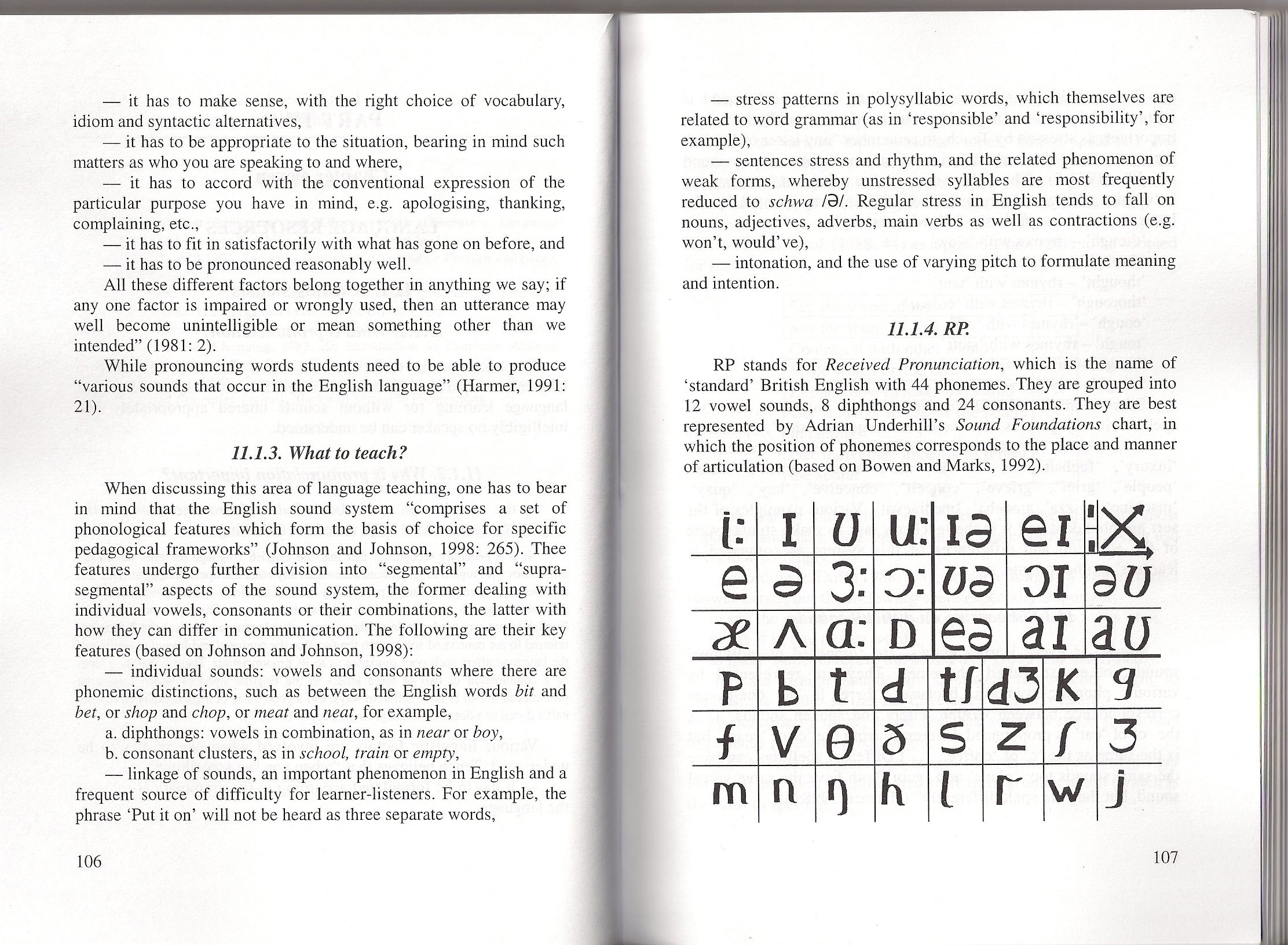skanowanie0053 (9)

— it has to make sense, with the right choice of vocabulary, idiom and syntactic altematives,
—- it has to be appropriate to the situation, bearing in mind such matters as who you are speaking to and where,
— it has to accord with the conventional expression of the particular purpose you have in mind, e.g. apologising, thanking, complaining, etc.,
— it has to fit in satisfactorily with what has gone on before, and
— it has to be pronounced reasonably well.
Ali these different factors belong together in anything we say; if any one factor is impaired or wrongly used, then an utterance may well become unintelligible or mean something other than we intended” (1981: 2).
While pronouncing words students need to be able to produce “various sounds that occur in the English language” (Harmer, 1991:
m
11.1.3. What to teach?
When discussing this area of language teaching, one has to bear in mind that the English sound system “comprises a set of phonological features which form the basis of choice for specific pedagogical frameworks” (Johnson and Johnson, 1998: 265). Thee features undergo further division into “segmental” and “supra-segmental” aspects of the sound system, the former dealing with individual vowels, consonants or their combinations, the latter with how they can differ in communication. The following are their key features (based on Johnson and Johnson, 1998):
— individual sounds: vowels and consonants where there are phonemic distinctions, such as between the English words bit and bet, or shop and chop, or meat and neat, for example,
a. diphthongs: vowels in combination, as in near or boy,
b. consonant clusters, as in school, train or empty,
— linkage of sounds, an important phenomenon in English and a ffeąuent source of difficulty for leamer-listeners. For example, the phrase ‘Put it on’ will not be heard as three separate words,
-— stress patterns in polysyllabic words, which themselves are related to word grammar (as in ‘responsible’ and ‘responsibility’, for example),
— sentences stress and rhythm, and the related phenomenon of weak forms, whereby unstressed syllables are most freąuently reduced to schwa /9/. Regular stress in English tends to fali on nouns, adjectives, adverbs, main verbs as well as contractions (e.g. won’t, would’ve),
— intonation, and the use of varying pitch to formulate meaning and intention.
11.1.4. RP.
RP stands for Received Pronunciation, which is the name of ‘standard’ British English with 44 phonemes. They are grouped into 12 vowel sounds, 8 diphthongs and 24 consonants. They are best represented by Adrian UnderhilFs Sound Foundations chart, in which the position of phonemes corresponds to the place and manner of articulation (based on Bowen and Marks, 1992).
|
1: |
i |
U |
u: |
ca |
e |
il |
m |
|
e |
3:: |
d: i |
J9 |
Ol |
UUM-f 9U | ||
|
ae |
A < |
a: |
D ( |
50 |
a |
I |
ao |
|
P |
b |
t < |
i i |
:/d |
[3 |
K |
9 |
|
i |
V 1 |
9 i |
5 S |
m |
z |
f |
3 |
|
m |
n |
1 1 |
\ i |
r |
5* ^ |
w |
m J |
107
Wyszukiwarka
Podobne podstrony:
skanowanie0053 (9) — it has to make sense, with the right choice of vocabulary,&nb
MIIB ABB IT CHALLENGE 2017We make ITinteract with the real world Zaprojektuj szerszy obraz świata i
loT Applications The challenge is to keep up with the rising cost of care of our aging population by
Easy Ways To Make Money With?cebook?n Pages Facebook Fan Page SfeafćftrafłfefcJes and Examples
‘A delightful tale with just the right touch of humor, vulnerability, and suspensę.” —Chniina Shyt.
He has established International Society for the Social Sciences of Sport (ISSSS) and Polish Society
skanowanie0094 (2) 12.3.3.1. Reading strategies Grauberg maintains that “reading strategies should h
Face Mobile 1 faceMojbile The lightest breeze will bring your character to life! It $ fun to make
067 Let s Learn?0928(1) Draw a linę from each dog to a doghouse that has a picture that begins with
calibre cover (192) ARA0ESOUEBEVERLY JENKINS ADRIANNĘ BYRDKIMBERLY KAYE TERRY ’Tis the season to mak
26953 skanowanie0094 (2) 12.3.3.1. Reading strategies Grauberg maintains that “reading strategies sh
26953 skanowanie0094 (2) 12.3.3.1. Reading strategies Grauberg maintains that “reading strategies sh
skanowanie0096 (2) is always preferable to start with the overall meaning of the text, its function
88 JOHN D. COONEY But when it comes to quoting sculptures in the round with this headdress much less
więcej podobnych podstron